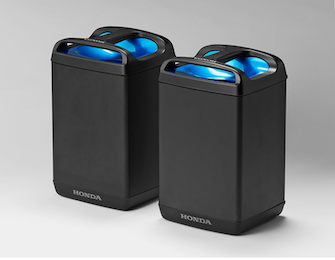Four major motorcycle manufacturers have joined together to help create standardized swappable motorcycle battery packs.
March 29, 2021

The question of range versus battery weight is more significant for battery-electric motorcycles than for any other type of electric vehicle (EV). The lighter you can make a motorcycle, the better its performance and the easier it is to handle, especially at low speeds and while parking.
In many parts of the world, two-wheel machines are practical everyday economical transportation, range is less important than price and maneuverability, so a smaller battery pack makes sense. In the US, motorcycles are more of a lifestyle choice and traditional US motorcycle riders expect a certain amount of range, certainly more than 100 miles on a charge. Finding a sweet spot for the size of the battery for the intended market is one of the biggest challenges for electric motorcycle designers.
Battery Swaps
What if a spent battery could be easily and quickly swapped out for a fully charged one? Battery swapping for full-size EVs has been proposed and even now a company in California called Ample has plans to swap their fully-charge bespoke pack in and out of existing EVs. The problem a pack for a full-size EV can weigh well over 1,000 pounds, and making and breaking electrical and cooling connections can be difficult.
Four Companies
An electric motorcycle, on the other hand, has a much smaller pack, and if the machine is designed with swappable batteries, the pack could be made even smaller, allowing adequate range when riding around town, and then battery swapping when going longer distances. That’s the concept behind a letter of intent for the creation of a swappable battery consortium that has been signed by Honda, Yamaha, KTM, and Vespa.
Members of the consortium believe that a standardized swappable battery system will promote the widespread use of light electric vehicles and provide better management of the batteries that are used in the transport sector. The manufacturers will also be able to address customer’s concerns about range anxiety by shortening charging times and providing a lower-cost solution while also building electric transportation infrastructure.
Standardization
Beginning in May 2021, and working with National, European, and International standardization bodies, the four founding members want to define and standardize the technical specifications of swappable batteries for mopeds, motorcycles, tricycles, and quad bikes. Stefan Pierer, KTM’s CEO said in a company news release, “Sustainability is one of the key drivers to the future of mobility and electrification will play a major role in achieving this goal. For powered two-wheelers, the constraints of electric drivetrains regarding range, charging time, and initial cost are still evident.” He went on to note, “To overcome these challenges and provide a better customer experience, a swappable battery system based on international technical standards will become a viable solution. Considering the entire lifecycle, a widespread application of batteries compliant with a common standard will support secondary use as well as circular economy.”
|
At the 2018 Consumer Electronic Show (CES), Honda demonstrated its swappable battery concept for a variety of lightweight personal mobility vehicles. These are two of the packs. |
KTM already builds an electric off-road motorcycle, the Freeride E-XC that features a quick-change swappable battery pack. The 3.9 kilowatt-hour (kWh) pack allows the bike to be lightweight and agile and, with a pair of packs one can be used for riding while the other is charging.
“The worldwide electrification effort to reduce CO2 on a global scale is accelerating, especially in Europe,” said Noriaki Abe, Managing Officer, Motorcycle Operations, Honda Motor Co., Ltd. In a Honda press release. Honda has dabbled with a variety of two-wheel electric mobility concepts, most notable showing a range of electric scooters and vehicles with swappable battery concepts at the Consumer Electronics Show (CES) in 2018.
“For the widespread adoption of electric motorcycles, problems such as travel distance and charging times need to be addressed, and swappable batteries are a promising solution,” Abe said. “Considering customer convenience, standardization of swappable batteries and wide adoption of battery systems is vital, which is why the four member manufacturers agreed to form the Consortium,” he added.
Big American Bikes
Although the idea of swappable batteries works well for mopeds, small motorcycles, and scooters, it may have limitations for larger, longer-range electric motorcycles like those built by American manufacturers Zero Electric Motorcycles, and Harley Davidson (Livewire). Zero builds a range of electric motorcycles, including some off-road models that have small swappable battery packs. Its longer range (160+ miles) street bikes have large 14.4 kWh packs that are too large for swapping. Battery Technology did not receive a response when it contacted Zero for comments about the consortium.
Traditional American motorcycle manufacturer Harley Davidson has also entered the electric motorcycle game with its Livewire model. With a 146 mile range from its 15.5 kWh battery system, it is another motorcycle that is just too large for practical battery swapping. Having put its foot into the water with the Livewire, it will be interesting to see where Harley Davidson goes with its future electric endeavors. Harley Davidson didn’t respond to our questions about the battery swapping consortium announcement.
Battery Swap Kiosks?
Moving forward it will be interesting to see if any other motorcycle manufacturers join the initial four in the consortium. One could envision an automated kiosk that would accept spent battery packs and dispense fully charged ones to allow riders on a range of scooters or motorcycles from different manufacturers to easily extend the range of their affordable bikes. It might work, and as Honda’s Abe noted, “Honda views improving the customers’ usage environment as an area to explore cooperation with other manufacturers, while bringing better products and services to customers through competition. Honda will work hard on both fronts to be the ‘chosen’ manufacturer for customer mobility.”
Kevin Clemens is a Senior Editor with Battery Technology.
About the Author(s)
You May Also Like






